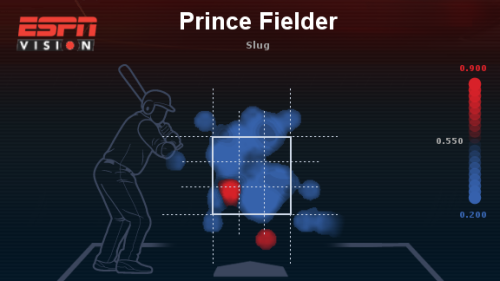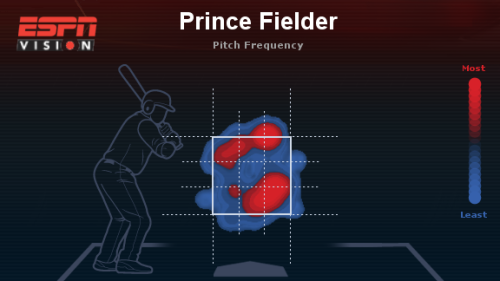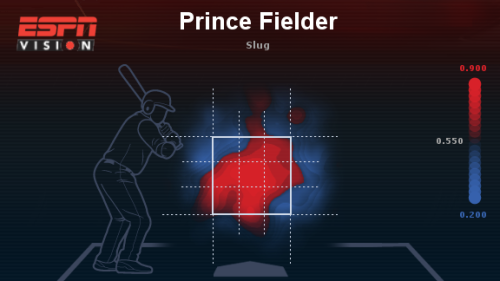Calling Prince Fielder
/ Three series into the 2014 campaign, and the Rangers find themselves sitting at 4-5, just a tick below .500, and the injury bug has reared its ugly head again. This time, the victim is -- somewhat unsurprisingly -- Adrian Beltre.
Three series into the 2014 campaign, and the Rangers find themselves sitting at 4-5, just a tick below .500, and the injury bug has reared its ugly head again. This time, the victim is -- somewhat unsurprisingly -- Adrian Beltre.
Beltre had an MRI yesterday, and while it remains to be seen what kind of time he'll be missing, no matter how much time that is, the Rangers will be left searching for ways to get the offense going on a more consistent basis. Tuesday's 9-4 win notwithstanding, the offense as a whole has been, at best, uninspiring.
A big portion of that has been due to the fact that Prince Fielder has yet to get going. Yes, it's still early -- although we're beginning to get to a point at which it becomes more difficult to use that as the line of reasoning -- so there's still plenty of time for Fielder to get things turned around. However, we're at least beginning to creep into the territory in which it's worrisome to see that he has yet to make the kind of power impact in the middle of the lineup that he was expected to make.
Thus far in 2014, Prince Fielder is carrying a .162/.205/.216 line, good for an OPS of .421. That all comes in 39 plate appearances, which, while a small sample size, is beginning to become large enough to start looking at some trends. For example, we can look at Fielders chase percentage, which comes from dividing swings by pitches outside of the strike zone.
In 2014, Fielder has a chase percentage of 34.8%. In 2013, his chase percentage was 28.1%. From 2009-2012, his chase percentage sat at 27.2%. I feel like I can't say it enough, that yes, it is early, but for a hitter that has been praised for his plate discipline, that discipline has been somewhat lacking this season, and it would appear he was even less patient in 2013 than his career norm. 2013, of course, prompted all kinds of chatter about a possible regression by Fielder, suggesting that perhaps he could already be experiencing the signs of an aging hitter.
OK, so perhaps just looking at chase percentage doesn't give us a very clear picture. So we look at a visual of Fielder's slugging so far in 2014.
 ESPN Stats & InformationThe absence of power has been fairly obvious to anyone watching the games, and Fielder's two extra-base hits would seem to back that up, and it isn't as if pitchers haven't been giving him pitches to hit. I wanted to take a look at fastballs being thrown to Fielder inside the strike zone, and the results were somewhat surprising.
ESPN Stats & InformationThe absence of power has been fairly obvious to anyone watching the games, and Fielder's two extra-base hits would seem to back that up, and it isn't as if pitchers haven't been giving him pitches to hit. I wanted to take a look at fastballs being thrown to Fielder inside the strike zone, and the results were somewhat surprising.
 ESPN Stats & InformationAccording to ESPN Stats & Information, Fielder has been thrown 42 fastballs in the strike zone thus far in 2014, which is depicted in the visual above. Both of his doubles are lumped into that 42-pitch total. So, I decided to go back and look at Fielder's 2013 slugging against fastballs, seen in the heat map below.
ESPN Stats & InformationAccording to ESPN Stats & Information, Fielder has been thrown 42 fastballs in the strike zone thus far in 2014, which is depicted in the visual above. Both of his doubles are lumped into that 42-pitch total. So, I decided to go back and look at Fielder's 2013 slugging against fastballs, seen in the heat map below.
 ESPN Stats & InformationAgain, 2013 was supposedly a "down" season for Fielder. He slugged .439 on fastballs. In comparison, we can look at the same heat map for 2009-2012.
ESPN Stats & InformationAgain, 2013 was supposedly a "down" season for Fielder. He slugged .439 on fastballs. In comparison, we can look at the same heat map for 2009-2012.
 ESPN Stats & InformationLooking at the visual alone, it's apparent that Fielder was feasting on fastballs pre-2013. If the visual doesn't do it for you, just make a mental note that his slugging percentage against fastballs from 2009-2012 was a robust .576, and his OPS was 1.014.
ESPN Stats & InformationLooking at the visual alone, it's apparent that Fielder was feasting on fastballs pre-2013. If the visual doesn't do it for you, just make a mental note that his slugging percentage against fastballs from 2009-2012 was a robust .576, and his OPS was 1.014.
In other words, before 2013, Fielder was a monster against the fastball, and yet since, he's struggled somewhat, which can sometimes indicate a loss of bat speed. Going off of the eye test, his bat has looked a bit slower at times than I'd like, but it's almost felt like a certain amount of hesitation on his part rather than struggling to get the bat through the zone.
It seems to be worth mentioning that so far in 2014, Fielder's BABIP is .188, which would seem to suggest that there should end up being a regression to the mean. In this case, that would mean that we begin to see more out of Fielder, who has a career BABIP of .302.
Whatever the case, the Rangers need Prince Fielder to get back to feasting on the fastball in order for the lineup to be effective moving forward. If Adrian Beltre misses any kind of significant time, the bulk of the pressure will fall on Fielder to carry the load, and how he responds may go a long way toward determining what kind of record the Rangers have heading into the summer months.
Even if Beltre is only out for a few games, this ball club won't be successful without a the power presence of Fielder in the middle. Shin-Soo Choo getting on base at a torrid pace only matters if there's someone to hit him in, and it's quite obvious that, at this point in his career, Beltre is going to need time off to rest his legs. The quad injury he suffered on Tuesday night happened on a night in which he was slated as the DH to try to get his legs some rest. If that doesn't work, you literally have to find ways to keep him out of the lineup for rest from time to time, but it's a risky proposition if Fielder's struggles continue.
There's certainly plenty of time for adjustment, and it would seem that Prince Fielder has the tools to make that happen. However, we've got some evidence that points to a disturbing trend that could indicate a loss of bat speed. Prince Fielder is going to be a Texas Ranger for a long time, and right now, the Rangers are calling on him to step it up and find a way to be a productive bat in the middle of the lineup.
